

25 February 2021 Media Release: How to apply for Tourism Road Signage

Media Release: How to apply for Tourism Road Signage
For Immediate Release 25 February 2021
Government and the private sector understands the importance of the Tourism Sector , in particular its impact on the economy. Tourism creates jobs, sustains livelihoods and promotes a country’s natural and cultural heritage. It is however important for each person to know where to find tourist attractions through clearly identifiable signs. Such signs are approved for five (5) years or rejected by a Regional Tourism Liaison Committee (RTLC) and in the case of the Western Cape, the Western Cape Provincial Government in collaboration with the South African National Roads Agency (SANRAL).
What do tourism road signs look like?
Tourism road signs in South Africa contain white symbols and lettering, displayed on a brown background. These signs are erected from the nearest numbered route, with additional signs indicating directions to a tourism attraction or facility. It does however become tricky in urban areas where there are a lot of signs, buildings, and other objects. This is why generic signs may be considered by the RTLC.
Purpose of tourism road signs?
The purpose of tourism road signs is not intended to advertise a tourism attraction, but to guide the public to a facility while a person can enjoy an excursion. Therefore, tourism road signs are intended to clearly indicate the route pedestrians and motorists need to travel along to reach specific attractions or facilities.
Who can apply for a tourism road sign?
Owners of registered tourism facilities and/or attractions may apply for tourism signs.
Approval of road signs
Approval for a tourism sign depends on the quality of the facility or service, the need for a road sign at a given point, and whether a sign can be erected without causing a traffic hazard.
Tourism road sign application process
Those interested in applying for a tourism road sign needs to contact their nearest Local Tourism Office (LTO) to discuss the requirements and to collect an application form. Each LTO is responsible for providing applicants with answers to specific requirements and indicate whether such a premises would be recommended by them. Once an applicant has completed all required documentation, it needs to be submitted to the issuing LTO. LTOs are subsequently responsible for submitting documents to the RTLC for review.
The evaluation of a facility by the LTO comprises of, amongst other things, compliance with warrants. Warrants serve as assurance of acceptable standards for a tourist, who is influenced to support the establishment by means of being exposed to the tourism road signage.
Approval of tourism road signage
If an application has been recommended by a LTO, or in some instances a Local Economic Development Unit of a Municipality, it will be forwarded to the RTLC and the Transport Directorate for review.
The requirements of Transport Authority vary according to the status of the road. More important mobility roads will have stricter requirements. Once the road authority has access to all the relevant documentation, information is processed in terms of the relevant road regulations. Technicalities such as the placing of the sign; distance from a crossing; number of existing signs; and the speed limit of the particular road where the sign is intended to be erected, are taken into account
When submissions are approved, an applicant will be furnished with a digital drawing of the sign. In addition to this, a list of approved manufacturers who conform to tourism standards will be provided too.
Rejection of tourism road signage
LTOs will provide clear reasons for why applicants have not been granted permission to erect tourism road signage. This decision will be preceded by an on-site inspection of the facility by the LTO to measure its compliance to a certain number of required tick-boxes.
If an applicant’s submission is rejected, SANRAL will inform the applicant of such a decision and provide the reasons behind it.
Fees payable
Applicants will be responsible for appointing a manufacturer to do the work in accordance with a letter of approval and for all costs related to the erection of the sign. SANRAL has specific conditions under which approval may be granted.
The tourism road sign is up, now what?
Once the sign has been erected, it becomes the property of SANRAL and may be relocated or removed at their discretion. Applicants remain responsible for the upkeep/ maintenance of their respective road signs.
If the applicant’s facility no longer complies with warrants, SANRAL may remove all tourism road signs. SANRAL or LTOs can, at any moment inspect a facility to ensure that it still meets the relevant authorised standards.
Contact information for offices responsible for signage:
*PLEASE NOTE
National roads are governed by the South African National Roads Agency (SANRAL), provincial roads by the Provincial Roads Department (PG: WC), district/secondary roads by the District Council and normal streets by the Local Municipality.*

“Manuals, Articles & Information on SARTSMA and Industry Related topics available to download”
Please note that all of the document below are in PDF format and you will require Adobe Reader. You can get Adobe Reader here.
Please note the below downloads will download in PDF format. You will require Adobe Reader to be installed on your PC to open the file. You can get Adobe Reader here.
SARTSMA Membership Tiers
This document outlines the different membership tiers available with SARTSMA.
SARTSMA Constitution
This document sets out the constitution that we adhere to and states the purposes of why we exist as an organisation.
SARTSMA Related Information
SARTSMA Membership Application & Tiers 2023
SARTSMA Value Proposition
SARTSMA Constitution 2021
Industry Related Information
COTO Chapter 1 (General), Chapter 11 (Ancillary Road Works) and 13 (Structures)
Retro-reflective Sheeting (Glass Beads & Micro Prisms) for Road Traffic Signs Identification Guide - 2021
South African Road Traffic Sign Chart
SARTSMA Guideline to Specifying Road Traffic Signs
Relevant Legislation
SADC Road Traffic Signs Manual - Volume 1
Volume 1 of the Manual contains detailed signing policy and design principles. The content of Volume 1 provides an in depth description of the road traffic sign system and working detail on the use of each individual component of the system.
The Chapters are as follows:- Ch1: General Principles, Ch2: Regulatory Signs, Ch3: Warning Signs, Ch4: Guidance Signs, Ch5: Information Signs, Ch6: Traffic Signals, Ch7: Road Markings, Ch8: Navigational Aids, Ch9: Variable Message Signs, Ch10: Glossary of Terms, Ch11: Index
South African Road Traffic Signs Manual - Volume 2
Volume 2 covers the collective application of signs, marking, and signals for specific subject areas such as traffic accommodation at roadworks, tourism signing, public transport signing and signing for the control of heavy vehicles.
The Chapters are as follows:- Ch1: Introduction, Ch2: Road Marking Application, Ch3: Regulatory and Warning Signs and Marking Applications, Ch4: Tourism Signing, Ch5: Freeway Signing, Ch6: Toll Route Signing, Ch7: Signing for Railway Crossings, Ch8: Public Transport Signing, Ch9: Urban Guidance Signing, Ch10: Rural Junction Signing, Ch11: Signing for Heavy Vehicles, Ch12: Signing for Traffic Calming, Ch13: Roadworks Signing, Ch14: Signing for Pedestrian Environments, Ch15: Structural Design of Road Signs, Ch16: Road Signs Management, Ch17: Sign Face Materials, Ch18: Road Marking Materials, Ch19: Variable Message Signs
South African Road Traffic Signs Manual - Volume 3
Volume 3 provides in depth detail on the selection, installation, operation and control methods for traffic signals.
The Chapters are as follows:- Ch1: Traffic Signal Control, Ch2: Traffic Signal Warrants, Ch3: Traffic Signal Faces, Ch4: Pedestrian and Pedal Cyclist Signals, Ch5: Junction Layout, Ch6: Signal Timing & Phasing, Ch7: Vehicle-Actuated Control, Ch8: Vehicle-Responsive Control, Ch9: Area Traffic Control, Ch10: Vehicle Priority, Ch11: Individual Vehicle Control Signals, Ch12: Signals at Roadworks, Ch13: Lane Direction Control Signals, Ch14: Railway Crossing Signals, Ch15: Hand & Other Signals, Ch16: Light Signals & Posts, Ch17: Facilities for Disabled Users, Ch18: Traffic Signal Controllers, Ch19: Central Control System, Ch20: Detectors, Ch21: Automated Law Enforcement, Ch22: Power Supply, Ch23: Responsibilities & Duties, Ch24: Risk Management, Ch25: Manpower Requirements, Ch26: Traffic Signal Installation, Ch27: Removal of Traffic Signals, Ch28: Traffic Signal Maintenance, Ch29: Signal Timing Upgrading, Ch30: Traffic Signal Records, Ch31: Contracts, Ch32: Annual Reports
SADC Road Traffic Signs Manual - Volume 4
Volume 4 provides complete dimensional details, together with accurate scalable drawings, of all signs, markings and signals, including details of all letter types used on direction signs.
The Chapters are as follows:- Ch1: Introduction, Ch2: Regulatory Signs, Ch3: Warning Signs, Ch4: Guidance Signs - 1 Location Signs and Route Marker Signs, Ch5: Guidance Signs - 2 Directions Signs, Ch6: Guidance Signs - 3 Freeway Directions Signs, Ch7: Guidance Signs - 4 Tourism Signs, Ch8: Guidance Signs - 5 Diagrammatic Signs, Ch9: Information Signs, Ch10: Traffic Signals, Ch11: Lettering for Road Traffic Signs, Ch12: Road Markings, Ch13: Guidance Signs - 6 Local Directions Signs, Ch14: Guidance Signs - 7 Pedestrian Direction Signs, Ch15: Guidance Signs - 8 Toll Direction Signs

- Warning Sign
- Information Sign
- Mandatory Sign
- Priority Sign
- Prohibitory Sign
South Africa Road Signs
Road signs in south africa - what do road signs in south africa mean.
If you’re driving in South Africa for the first time, you should learn the road signs before hitting the road…

Warning Road Signs in South Africa
Warning signs in South Africa are often red or yellow to advise of potential danger. You should take note of any warning signs in South Africa as they are designed to alert you of possible dangers ahead.
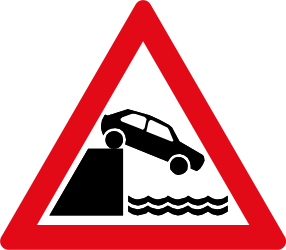
Information Road Signs in South Africa
Information signs in South Africa are the most frequently used road signs in South Africa and are generally used on any type of road to provide road users with general information about the road they are using and the road ahead.
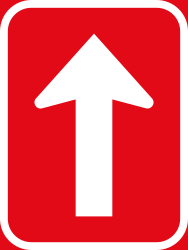
Mandatory Road Signs in South Africa
Mandatory road signs in South Africa are used where you are required to carry out a specific task, they are not suggestions, information or advisory signs, they must be adhered to and as such are arguably the most important roads signs in South Africa that you need to know.
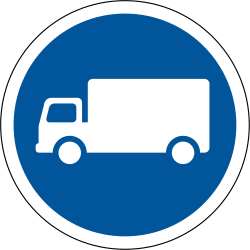
Priority Road Signs in South Africa
Priority road signs in South Africa are designed to clarify who has priority at the junction / road ahead. If driving in a country where you drive on the other side to the road, priorities are likely to the opposite of what you are familiar with, roundabouts being a notable difference.
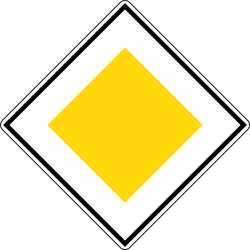
Prohibitory Road Signs in South Africa
Prohibitory road signs in South Africa are used on all road types in South Africa, often to restrict certain types of vehicles and certain manoeuvres such as prohibiting u-turns or setting maximum speeds.
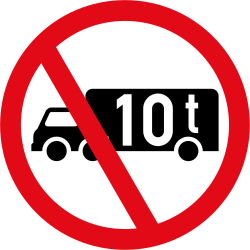
Visitor Comments
Jeni.robinson.
guidance signs
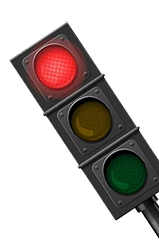
These signs give guidance regarding the route and include, for example, distances and directions to destinations and public facilities, as well as traffic lane situations ahead.
Guidance sign for freeways: white/yellow on a blue board.
Guidance sign for other roads: white/yellow on a green board.
Diagrammatic lane guidance: red/black on a white board.
Tourist guidance signs: white/yellow on a board.

Local direction signs: black on white signs within a town or city.
These symbols give the name of a town, street, river, freeway, interchange and so on.
River name symbol.
Toll road name symbol.
End of toll road name symbol.
Dual carriage freeway name symbol.
Single carriage freeway name symbol.
Interchange name symbol.
Conservancy name symbol.

Municipality.
Interchange.
Mountain pass.
These symbols indicate the nature of the destination to which the direction sign is pointing.
Railway station.
Bus terminus.
Power Station.
Industrial Area.
Shopping Centre.
City Centre/CBD.
Toll route.
Alternative route.
Detour direction.
Bicycle route
Park and ride train.
Park and ride bus.
Pick up point.
Parking area.
Mini-bus rank.
Toll plaza.
Border/customs post.

Freeway route number.

Metro route number south.

Regional route number.
National route number.

SADC route number.
These symbols are found in a town or city to indicate the nature of the destination to which the white direction sign is pointing.
Business centre.
Shopping centre.
Bus station.
Parking garage.
Information centre.
Post office.
Industrial area.
Produce market.
Conference facilities.
Power station.
Swimming pool.
Fire station.
Border post/customs.
These symbols indicate the nature of the tourist attractions or amenities and facilities available to tourists.
Generic national park.
Generic cultural.
Amphitheatre.
National Park.
Hiking trail.
Horse trail.
4 x 4 trail.
Biking trail.
River rafting.
Scuba diving.
Ballooning.
Namibian national park.
Generic farm.
Wine cellar.
Wine route/estate.
Showground.
Cherry farm.
Ostrich farm and riding.
Ostrich farm.
Butterfly farm.
Animal theme park.
Generic provincial park.
Gauteng provincial park.
Free State provincial park.
Western Cape Provincial Park.
KwaZulu Natal provincial park.
Generic resorts.
Country golf club.
Hot springs.
Inland water.
Seaside/beach.
Berg/mountain.
Nature reserve.
Forrest reserve.
Scenic route.
National heritage site.
Botanical gardens.
Gardens(flowers).
View point.
Natural forest.
Motor racing track.
Horse racecourse.
Equestrian events.
Cricket field.
Sports stadium.
Conservancy area.
Game reserve.
Bird park/ sanctuary.
Snake park.
Crocodile park.
Rhino park.
Historical place.
Namibian national monument.
National monument.
Historic mine.
Historic railway station.
Historic battlefield.
Historic cemetery.
Geological site.
Coastal tourist attractions.
Marine reserve.
Oceanarium.
Maritime museum.
Lighthouse.
Boat launch.
Coastal fishing.
Arts & crafts.
Painting and drawing.
Weaving and knitting.
Leatherwork.
African arts and crafts.
Emergency cellphone number.
Namibian police.
RSA police.
First aid post.
SOS call station sign.
Ambulance/medical service.
Fire station services.
Filling station and workshop.
Filling station.
Tow in service.
Truck rest and service area.
Restaurant.
Refreshments.
Small shops.
Free parking area.
Roadside stall/curio shop.
Drinking water.
Cooking facilities.
Picnic area.
Tourist information.
Facility for the handicapped.
Rest area class 1.
Rest area class 2.
Rest area class 3.
Delivery vehicles.
Motorcycles.
Accommodation (hotels, inns etc.)
Guest farm.
Ethnic (Zulu).
Chalet/self-catering.
Camping site.
Guest house.
Bed & Breakfast.
Bed (rooms only).
Youth hostel/centre/camp.
Trail shelter.
Straight on.
To the right.
Diagonally to the right.
To the right ahead.
Exit route number.
Truck wash.

The white signs or inserts are local direction signs within a town or city.

These signs give guidance in respect of the layout or use of traffic lanes ahead.
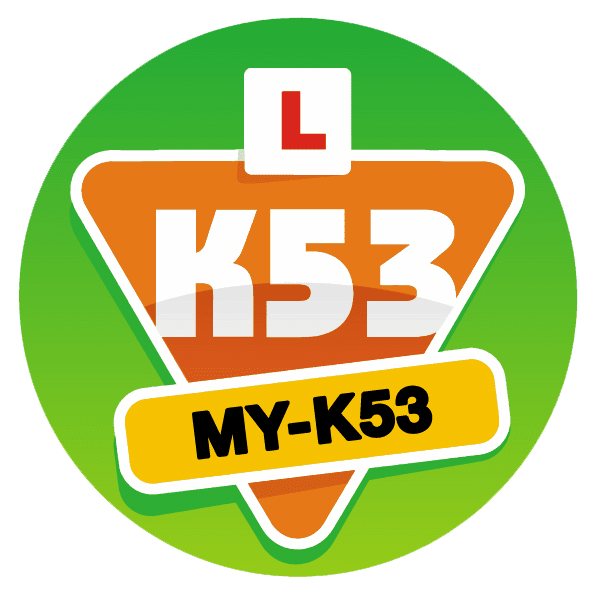
Road signs in South Africa
K53 Learner's License Guides | 0 comments

This section covers guidance, information, regulatory, and warning signs for your South African learner’s license test .
Road sign groupings
K53 road signs get grouped into the following categories:.
- Guidance and information signs.
- Regulatory signs.
- Warning signs.
- Temporary signs
Guidance and information signs
Guidance and information signs get grouped as follows:.
- Location signs.
- Route marker signs.
- Direction signs.
- Tourism signs.
- Diagrammatic signs.
- Information signs.
Location signs
- Display the name of the place you have reached or are about to arrive.
- Some signs are grouped with a symbol to indicate the type of location.

Route marker signs
These signs indicate a particular route or the direction you need to travel to get to a specific route.

Direction signs
- Indicate the direction to places and routes.
- Many of these signs are combinations of several directions and route marker signs.
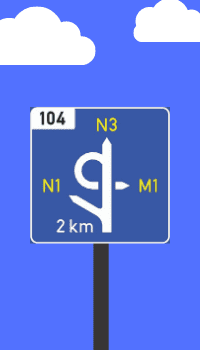
Tourism signs
Give you direction and information as a tourist on places of interest, services or rest facilities.

Diagrammatic signs
Indicate the pattern of traffic lanes ahead of you or important instructional information. The below sign instructs heavy goods vehicles to engage a lower gear.

Information signs
Display general information. The sign below indicates that a turn to the left leads to a dead end.
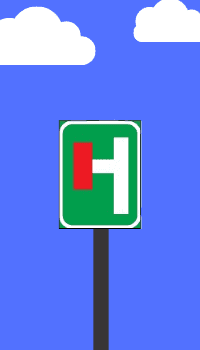
Regulatory road signs
Regulatory road signs are categorised as follows:.
- Control signs.
- Command signs.
- Prohibition and limit signs.
- Reservation signs.
- Exclusive secondary signs.
- Comprehensive signs.
- De-restriction signs.
Control signs
Control the actions of a driver. The stop sign is an example of a control sign. You must bring your vehicle to a complete stop when you see a stop sign

Command signs
- You must follow the indication for an action that the driver must take.
- This sign indicates you must travel at a minimum speed of 50km/h.

Prohibition & limitation signs
- Prohibit you from performing specific actions.
- These signs instruct you on the limits that must be adhered to.
- In this example, the sign is a regulatory limit sign limiting drivers to a speed of 100km/h.
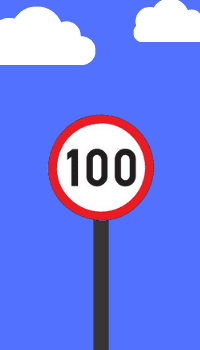

Reservation signs
Indicate that the roadway, lane or parking area used is for certain classes of vehicles only.
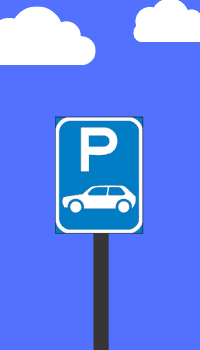
Exclusive secondary signs
- These signs are grouped with any regulatory sign to indicate that it applies only to that situation.
- In this example, the exclusive secondary sign is the motorcycle illustration. It’s grouped with a regulatory limit sign.
- The signs indicate you must drive at a speed limit of 100km/h if riding a motorcycle.
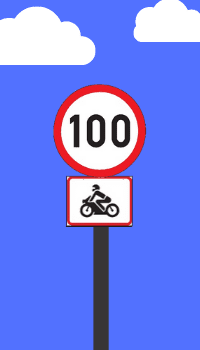
Comprehensive signs
- Comprehensive signs indicate that you are about to enter a roadway or area governed by a complete set of rules.
- This sign indicates you are entering a residential area and that children may be at play.
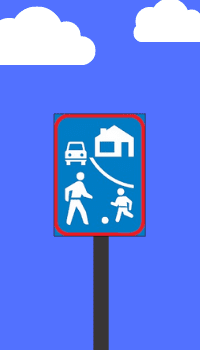
De-restriction signs
De-restriction signs indicate that you are about to exit a roadway or area governed by a comprehensive set of rules.

Warning signs
Warning signs are categorised as follows:.
- The direction of travel signs.
- Symbolic signs.
- Hazard warning markers.
- Road layout signs.
The direction of travel signs
- Indicate the direction of travel that lies ahead by using arrows. You can see from the indicators that the direction of travel is circular.
- In this example, the sign indicates a warning to you that there is a roundabout ahead.

Symbolic signs
- Use symbols to indicate the nature of what lies ahead of you.
- In this example, the symbol used is a control sign (stop).
- The warning sign indicates there is a stop street ahead of you. This way, you are not taken by surprise by a sudden stop.

Hazard warning markers
- These markers enhance driver safety and get placed near a hazard indicating the position of the danger.
- In this example, the risk is to the left.
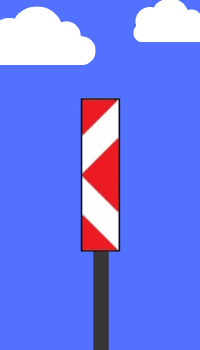
Road layout signs
- Indicate the layout of the road ahead.
- In this example, the sign warns you that the two-lane road you are travelling will begin to split.
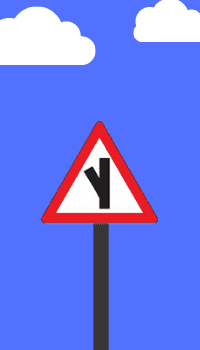
Learner’s License Guides

K53 car controls & the defensive driving method
K53 Learner's License Guides
Understanding the K53 car controls & the defensive driving method lays a solid foundation for how to manoeuvre a vehicle correctly.
You must know your car controls to pass your South African learner’s license test.

Rules of the road in South Africa, part one
The rules of the road keep all road users safe. Following the rules also keeps you out of trouble with the law.
When preparing for your learners’ license test, you must know the road rules.
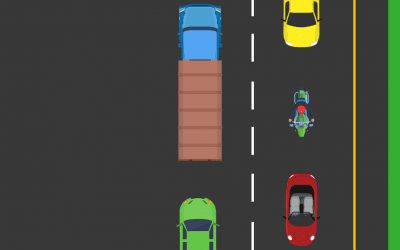
Road rules in South Africa, the second part.
Road rules in South Africa, the second part covers freeways, stopping areas, how to transport goods and when a vehicle gets considered abandoned.

Road rules for K53, the last part
K53, rules of the road 3 cover pedestrian crossings, collisions and accidents, tyre care, rules for your engine, hooter and cellphones.

Road markings in South Africa
This section includes the road markings in South Africa you need to know for your South African learner’s license test.
Regulatory road markings, longitudinal regulatory road markings, exclusive parking bay symbols, road guidance markings and last, road warning markings.

K53 traffic lights and signals
K53 traffic lights and signals are in three categories.
They are traffic lights, traffic officer hand signals and construction worker hand signals. All of this is covered right here in this guide.
Pin It on Pinterest

Guidance Signs
Guidance signs and symbols are provided as navigational aids to complement a complex and developing road and street network. These include direction, tourist information, confirmation, exit sequence, location and town name signs, and street name signs and property numbers, give en route navigation information to guide road users during journeys with minimal disruption to themselves or others.

Route Marker

Location signs Symbols GLS-1 River name GLS-2 Toll route name GLS-3 End of toll route GLS-4 Dual carriageway freeway name (Class A-1)
GLS-5 Single carriageway freeway name (Class A-2) GLS-6 Interchange name GLS-7 Conservancy area
Signs GL1 Street name GL2 Suburb name GL3 Town or city name GL4 River name GL5 National or provincial border GL6 Geographical location GL7 Route name GL8 Interchange name
Direction signs
Symbols GDS-1 Railway station
GDS-2 Bus terminus
GDS-3 Airport
GDS-4 Freeway (Class A-1) GDS-5 Freeway (Class A-2) GDS-6 Power station GDS-7 Industrial area GDS-8 City centre/central business district
GDS-9 Toll route
GDS-10 Alternative route
GDS-11 Heliport
GDS-12 Mine
GDS-13 Harbour
GDS-14 Shopping centre
GDS-15 Library
GDS-16 Bicycle route
GDS-17 Park ‘n ride (train)
GDS-18 Park ‘n ride (bus)
GDS-19 Pick-up point
GDS-20 Parking
GDS-21 Minibus rank
GDS-22 Toll plaza ahead
GDS-23 Border/customs post
Signs GD1/GD2 Stack-type composite direction
GD2 Stack-type direction GD4 Fingerboard
GD9 Map-type advance direction
GD10 Overhead advance direction
GD12 Overhead advance direction
GA2 Advance exit direction
GA3 Exit direction
GA4 Gore exit direction
GA4(E) Gore exit direction
GA8 Exit sequence
GB1 Cross-road advance direction
GB2 Near-side on-ramp direction
GB3 Far-side on-ramp advance
direction GB4 Far-side on-ramp direction
GC1 Overhead pre-advance exit direction GC3U Overhead supplementary exit/through direction
GB3(+IN25) Far-side advance direction toll tariff combination GA7A Confirmation alternative route (Class A1)
Route marker signs Signs GE2 Advance trailblazer GE9 Advance transport trailblazer
GE18.3 Tourism route marker
GE19.3SADC route marker sign
Tourism Signs
GFS A1 Generic - National park
GFS A1-1 National parks
GFS A2 Generic - Provincial parks
GFS A2-1 Provincial parks Gauteng
GFS A2-2Provincial parks Free State
GFS A2-3 Provincial parks Western Cape
GFS A2-4 Provincial Parks Kwazulu-Natal
GFS A3 Generic - Resorts
GFS A3-1 Country clubs (Golf)
GFS A3-2 Hot springs
GFS A3-3 Inland water
GFS A3-4 Seaside/beach
GFS A3-5 Berg/mountain
GFS A4 Generic - Scenic
GFS A4-1 Nature reserve
GFS A4-2 National Heritage site
GFS A4-3 Botanical Gardens
GFS A4-4 Gardens (Flowers)
GFS A4-5 Waterfall
GFS A4-6 Lake or dam (No watersport)
GFS A4-7 Caves
GFS A4-8 View point
GFS A4-9 Forest (Natural)
GFS A4-10 State forest
GFS A4-11 Mountain/berg
GFS A5-1 Motor racing track
GFS A5-2 Golf course
GFS A5-3 Horse racecourse
GFS A5-4 Equestrian events
GFS A5-5 Fishing
GFS A5-6 Cricket field
GFS A5-7 Swimming pool
GFS A5-8 Sports stadium
GFS A6 Generic - Wildlife
GFS A6-1 Conservancy area
GFS A6-2 Game reserve
GFS A6-3 Bird park/sanctuary
GFS A6-4 Zoo
GFS A6-5 Snake park
GFS A6-6 Crocodile park
GFS A6-7 Rhino park
GFS A6-8 Lion park
GFS A7 Generic - Historical
GFS A7-1 National monument
GFS A7-2 Museum
GFS A7-3 Historic mine
GFS A7-4 Historic railway station
GFS A7-5 Historic battlefield
GFS A7-6 Historic cemetry
GFS A7-7 Geological site
GFS A8 Generic - Coastal
GFS A8-1 Marine reserve
GFS A8-2 Maritime museum
GFS A8-3 Aquarium
GFS A8-4 Whales
GFS A8-5 Dolphins
GFS A8-6 Lighthouse
GFS A8-7 Dockyard
GFS A8-8 Boat launch
GFS A8-9 Fishing
GFS A8-10 Crayfish
GFS A8-11 Oceanarium
GFS A8-12 Beach
GFS A9 Generic - Arts & craft
GFS A9-1 Painting & drawing
GFS A9-2 Pottery
GFS A9-3 Jewellery
GFS A9-4 Weaving & knitting
GFS A9-5 Leatherwork
GFS A9-6 African arts & crafts
GFS A9-7 Woodwork
GFS A9-8 Metalwork
GFS A10 Generic - Cultural
GFS A10-1 Theatre
GFS A10-2 Amphitheatre
GFS A11-1 Hiking trail
GFS A11-2 Horse trail
GFS A11-3 4x4 trail
Tourism signs (continued)
GFS A11-4 Bike trail
GFS A11-5 River rafting
GFS A11-6 Scuba diving
GFS A11-7 Ballooning
GFS A12 Generic - Farming
GFS A12-1 Wine cellar
GFS A12-2 Wine route/estate
GFS A12-3 Showground
GFS A12-4 Cherry farm
GFS A12-5 Ostrich farm & riding
GFS A12-6 Ostrich farm
GFS A12-7 Fish farm
GFS A12-8 Roadside stall
GFS A12-9 Butterfly
GFS A13-1 Animal theme park
GFS B1-1 Telephone
GFS B1-2 Police
GFS B1-3 Hospital (with name)
GFS B1-4 First aid post
GFS B1-5 SOS call station (sign)
GFS B1-6 SOS call station (post)
GFS B1-7 NSRI
GFS B1-8 Ambulance/medical services
GFS B1-9 Fire station/services
GFS B1-10 Cell phone emergency number
GFS B2-1 Filling station & workshop
GFS B2-2 Filling station
GFS B2-3 Workshop
GFS B2-4 Tow-in service
GFS B3-1 Truck rest & service area
GFS B4-1 Restaurant
GFS B4-2 Refreshments
GFS B4-3 Take-away
GFS B4-4 Rural shop/cafe/corner shop
GFS B5-1 Parking area (free parking)
GFS B5-2 Toilets
GFS B5-3 Shower
GFS B5-4 Drinking water
GFS B5-5 Fireplace
GFS B5-6 Cooking facilities
GFS B5-7 Picnic area
GFS B5-8 Tourist information
GFS B5-9 Facility for handicapped
GFS B5-10 Roadside stall/curio shop
GFS B5-11 Post office
GFS B6-1 Rest area (Class 1)
GFS B6-2 Rest area (Class 2)
GFS B6-3 Rest area (Class 3)
GFS B7-1 Motor cars
GFS B7-2 Caravans
GFS B7-3 Buses
GFS B7-4 Trucks
GFS B7-5 Delivery vehicles
GFS B7-6 Motor cycles
GFS C1-1 Accommodation (incl. hotels, inns etc.)
GFS C1-2 Chalet/self catering
GFS C1-3 Caravan site
GFS C1-4 Camp site
GFS C1-5 Guest house
GFS C1-6 Bed & breakfast
GFS C1-7 Rooms (bed only)
GFS C1-8 Youth hostel/centre/camp
GFS C1-9 Trail shelter
GFS C1-10 Guest farm
GFS C1-11 Ethnic (Zulu)
GFS D1-1 Motor cars
GFS D1-2 Caravans
GFS D1-3 Buses
GFS D1-4 Trucks
GFS D1-5 Motor cycles
GFS D1-6 Take-away
GFS D1-7 Restaurant
GFS D1-8 Refreshments
GFS D1-9 Shop
GFS D1-10 Facility for handicapped
GFS D1-11 Toilets
GFS D1-12 Telephone
GFS D1-13 Straight-on arrow
GFS D1-14 Left/right arrow
GFS D1-15 Diagonal left/right arrow
GFS D1-16 Advance left/right arrow
GFS D1-17 Exit (route number)
GFS D1-18 Parking
GFS D1-19 Filling station & workshop
GFS D1-20 Filling station
GFS D1-21 Picnic area
GFS D1-22 Tourist information
GFS D1-23 Motor car wash
GFS D1-24 Truck wash
GFS D1-25 Drinking water
GFS D1-26 Fireplace
GFS D1-27 Cooking facilities
GFS D1-28 Shower
GF1 Freeway advance exit GF2 Advance turn GF3 Final turn GF8 Service exit sequence GF9 Rest & service sequence GF12 Advance roadside emergency service
GF17 Part-time attraction
GDLS A1-1 Central business centre
GDLS A1-5 Shopping centre
GDLS A1-6 Railway station
GDLS A1-7 Airport
GDLS A1-8 Bus station
GDLS A1-9 Minibus rank
GDLS A1-10 Harbour
GDLS A1-11 Parking
GDLS A1-12 Parking garage
GDLS A1-14 Mine
GDLS A2-1 Information centre/layby
GDLS A2-2 Post office
GDLS A2-4 Industrial area
GDLS A2-6 Waste disposal site
GDLS A2-7 Produce market
GDLS A2-9 Conference facilities
GDLS A2-11 Power station
GDLS A2-12 School
GDLS A2-13 Library
GDLS A2-14 Swimming pool
GDLS A2-15 Border/customs post
GDLS A4-3 Fire station
GDLS A4-5 Heliport
GDL1 Advance local direction
GDL2 Local direction GDL3 Local fingerboard
GSS-1 Arrestor bed GSS-2 Change to lower gear
GS103 Traffic movement affected by obstruction
GS205 Additional lane GS302 Lane use control by regulatory sign
GS403 Lanes merge
GS501 Arrestor bed pre-advance exit GS505 Engage lower gear GS605 Overhead lane use control by regulation sign
GS701 Public transport GS818 At grade lane layout GS901 Junction with warning sign GP4 Arrow left GP17 Buses GP18 Minibuses GP3 Arrow right
VM1 Sliding sign (W333 plus IN11.1) VM2 Roller blind sign (TR201) VM3 Rotating plank sign (Blank & tr210) VM4 Rotating disc sign (R201) VM5 Freeway “direction sign” changes to “no entry” sign
VM6 TW333 plus IN11.1 VM7 TW353 VM8 TR201 plus TW339 plus IN11.4

Are there any specific road signs or rules that I should be aware of in South Africa
by Editor | Jan 26, 2024 | Driving Lessons | 0 comments

Driving in a new country can be a bit daunting, especially when it comes to understanding the specific road signs or rules. In South Africa, there are specific road rules and common road signs that every driver should be aware of to ensure a safe and smooth journey.
From driving on the left side of the road to understanding specific road signs, this article will cover everything you need to know about the basic road rules , common road signs, and specific road rules in South Africa. So, buckle up and let’s hit the road!
What Are the Basic Road Rules in South Africa?
Understanding the basic road rules in South Africa is crucial for all drivers to ensure safety and compliance with traffic laws and regulations .
These rules encompass various aspects to ensure road safety.
Speed limits play a significant role in controlling the flow of traffic, with different limits applying to urban and rural areas.
Traffic signals direct the movement of vehicles and must be strictly adhered to.
Pedestrian crossings require drivers to yield to pedestrians, prioritizing their safety.
Overtaking guidelines are in place to prevent reckless maneuvers.
Vehicles must adhere to specific requirements, such as roadworthiness and licensing .
Defensive driving is essential in navigating diverse road conditions and hazards, promoting a safe driving culture.
Drive on the Left Side of the Road
In South Africa, it is imperative to drive on the left side of the road as per traffic laws and regulations, ensuring compliance with specific road signs and vehicle requirements.
This practice is crucial for maintaining safe and smooth traffic flow, as it reduces the risk of head-on collisions and enhances overall road safety. Adhering to road signs like speed limits , warnings , and directional indicators is essential to anticipate and respond to potential hazards.
Understanding driving techniques such as proper lane changing and intersection navigation plays a pivotal role in preventing accidents. Ensuring that the vehicle specifications, such as headlights and mirrors , comply with legal standards contributes to a safer driving environment for all road users.
Follow Speed Limits
Adhering to speed limits in South Africa is essential to ensure safe driving practices and compliance with traffic regulations, as indicated by specific road signs and traffic signals.
Respecting speed limits plays a crucial role in averting potential accidents and maintaining orderly traffic flow.
Drivers must acknowledge the significance of road signs and traffic signals , which serve as essential guidelines for safe and efficient driving.
Driving etiquette, such as yielding to pedestrians and signaling before changing lanes , contributes to a harmonious and safe driving environment.
It is important to recognize that enforcement mechanisms, such as speed cameras and traffic police , are in place to uphold these regulations, and violations can result in penalties, fines, and even license suspensions .
Wear Seatbelts at All Times
Ensuring the use of seatbelts at all times in South Africa is a critical safety measure and a legal requirement under traffic laws and regulations, emphasizing the importance of vehicle safety and compliance.
Wearing seatbelts not only reduces the risk of serious injury or fatality in the event of a collision but also plays a key role in upholding road safety standards.
Failure to comply with seatbelt regulations can result in fines and penalties. Law enforcement agencies actively monitor and enforce seatbelt usage to ensure the protection of all road users.
It is imperative for drivers and passengers to recognize the importance of buckling up as a responsible practice that contributes to overall road safety and wellbeing.
Use Headlights During the Day
Using headlights during the day in South Africa is a safety precaution recommended to enhance visibility, comply with traffic laws, and mitigate potential road hazards and challenging road conditions.
This practice not only helps drivers to see and be seen better, but also plays a crucial role in ensuring road safety for all road users.
South Africa experiences diverse weather conditions and terrains, from bright sunlight to foggy and overcast days, making it essential for drivers to adapt to these changing environments.
The use of headlights during the day is a regulatory requirement in South Africa, with non-compliance potentially leading to penalties.
By integrating this simple practice into their driving routines, motorists contribute to a safer and more visible road environment, thus reducing the risk of accidents and promoting responsible driving .
What Are the Common Road Signs in South Africa?
Familiarizing oneself with the common road signs in South Africa, including traffic signals, speed limits, pedestrian crossings, road markings, and parking restrictions, is important for all drivers to ensure safe and lawful navigation.
These indicators serve as crucial guidelines for drivers, promoting smooth traffic flow and enhancing road safety.
Traffic signals , such as stop signs , traffic lights , and yield signs , regulate the right of way at intersections, reducing the risk of accidents. Speed limit signs strategically placed along roadways ensure responsible driving and decreased chances of collisions.
Pedestrian crossings and their corresponding signs prioritize the safety of pedestrians, requiring motorists to yield and allow safe passage. Road markings , such as lane dividers and directional arrows , facilitate organized traffic, and parking restrictions help manage congestion and maintain order in public spaces.
Stop signs in South Africa serve as crucial road indicators, highlighting the need for drivers to comply with traffic laws and regulations, while emphasizing the significance of road signs and traffic signals in ensuring safe and orderly traffic flow.
Stop signs play a vital role in regulating vehicular movement at intersections. They help avoid potential collisions and ensure a smooth traffic flow.
These signs are an essential part of traffic management, guiding drivers to make informed decisions while navigating roadways. They contribute to the overall safety of both motorists and pedestrians by creating a structured and organized environment for vehicular travel.
By obeying stop signs , drivers contribute to a safer and more efficient road system. This promotes compliance with traffic rules and enhances overall traffic management.
Yield Signs
Yield signs are integral road markers in South Africa, indicating the need for drivers to yield to oncoming traffic or pedestrians in compliance with traffic laws, regulations, and the significance of road signs and traffic signals for safe and orderly traffic management.
Yield signs play a crucial role in promoting traffic safety and reducing the risk of accidents. They ensure that vehicles and pedestrians can move through intersections and other traffic points harmoniously. These signs also help in regulating traffic flow, preventing congestion, and minimizing the potential for collisions. They serve as a reminder for drivers to be courteous and considerate towards other road users, contributing to a more respectful and cooperative driving environment.
Speed Limit Signs
Speed limit signs in South Africa convey specific legal restrictions on driving speeds, underscoring the importance of compliance with traffic laws, regulations, and driving etiquette for safe and lawful travel.
Road signs play a crucial role in promoting road safety. They guide drivers to maintain appropriate speeds, reducing the risk of accidents and collisions.
These signs also promote responsible driving behavior, reminding motorists to prioritize the well-being of fellow road users and adhere to the prescribed speed limits. By obeying these signs, drivers contribute to the harmonious flow of traffic, minimize congestion, and ultimately create a safer driving environment for everyone.
No Overtaking Signs
No overtaking signs in South Africa convey restrictions on overtaking maneuvers, emphasizing the need for drivers to adhere to traffic laws, regulations, and driving etiquette to ensure safe and considerate driving practices .
These signs play a crucial role in promoting traffic safety by preventing risky overtaking actions that could lead to collisions and endanger the lives of drivers and passengers.
By clearly indicating areas where overtaking is prohibited, they contribute to reducing accidents and promoting the efficient flow of traffic. They serve as a reminder for drivers to prioritize the safety of all road users and exhibit courteous driving behavior in line with traffic laws and driving etiquette, ultimately fostering a culture of responsibility and respect on the roads.
Road Work Signs
Road work signs in South Africa are essential indicators of ongoing construction or maintenance activities, emphasizing the need for drivers to exercise caution, anticipate road hazards, and prioritize traffic safety in challenging road conditions.
These signs play a crucial role in not only alerting drivers to potential road hazards but also in promoting safety awareness and encouraging cautious driving practices.
By providing clear and visible warnings about construction or maintenance zones, these signs help drivers navigate through these areas effectively, reducing the risk of accidents and ensuring the safety of both motorists and construction workers.
Road work signs contribute to enhancing overall road safety and promoting a culture of responsible and considerate driving within the community.
Are There Any Specific Road Rules I Should Know About in South Africa?
In addition to the basic road rules, there are specific regulations and considerations in South Africa related to tolls, toll roads, roundabouts, animals on the road, pedestrian crossings, and emergency vehicles that drivers should be aware of to ensure safe and compliant travel.
Toll roads in South Africa require drivers to pay tolls, and it’s essential to have the correct change or electronic pass to facilitate smooth passage.
When approaching a roundabout, it’s crucial to give way to traffic from the right and signal your intentions clearly to avoid confusion.
In rural areas, drivers should be cautious of animals crossing, particularly in the early morning and late evening.
Respecting pedestrian crossings and yielding to pedestrians is fundamental for road safety.
When emergency vehicles are approaching with sirens and lights, drivers must pull over and yield to let them pass quickly.
Tolls and Toll Roads
Understanding the regulations and procedures related to tolls and toll roads in South Africa is crucial for drivers to navigate designated routes, comply with specific rules, and address enforcement requirements for smooth and lawful travel.
Being familiar with the toll-related rules ensures that motorists are aware of the payment methods and any exemptions available. It also helps in avoiding penalties and fines due to non-compliance with toll collection procedures.
Understanding the enforcement mechanisms , such as license plate recognition technology and infringement notices, is essential for a hassle-free and legal travel experience when utilizing toll roads. By adhering to these regulations, drivers contribute to a safer and more efficient road network in South Africa.
Roundabouts
Navigating roundabouts in South Africa requires drivers to understand specific traffic flow patterns, yield appropriately, and prioritize traffic safety to ensure smooth and efficient intersection management in compliance with road rules.
The design of roundabouts is aimed at promoting a steady flow of traffic, reducing the need for traffic signals, and enhancing safety.
When approaching a roundabout, drivers must slow down, observe the yield signs, and give way to any vehicles already in the roundabout. Signaling intentions and maintaining a consistent speed within the roundabout are crucial for preventing accidents and ensuring a smooth transition for all drivers.
These considerations emphasize the importance of proper traffic flow management and yielding to other vehicles to maintain safe and efficient roundabout usage.
Animals on the Road
Encounters with animals on the road in South Africa necessitate caution, awareness of potential wildlife hazards, and responsible driving practices to mitigate risks and ensure safety for both drivers and animals in compliance with road rules.
Drivers must recognize that roadways often intersect with the natural habitats of animals, requiring careful navigation. By being mindful of signage and reducing speed in these areas, collisions with animals can be significantly decreased.
It is important to understand the behavior of different species and anticipate their movement patterns to prevent accidents and promote a harmonious coexistence between vehicles and wildlife.
Pedestrian Crossings
Respecting pedestrian crossings in South Africa is essential to ensure the safety and right of way for pedestrians. Drivers must adhere to specific regulations, prioritize traffic safety, and yield appropriately in compliance with road rules.
Pedestrian safety is a critical concern on South African roads. Pedestrians are vulnerable users who rely on drivers to obey traffic laws and yield to them at designated crossings. By respecting pedestrian crossings, drivers contribute to creating a safer and more orderly traffic environment. This reduces the risk of accidents and promotes a culture of mutual respect and consideration between all road users.
Prioritizing the safety of pedestrians not only aligns with regulatory compliance, but also demonstrates a commitment to fostering a community where everyone can move about with confidence and security.
Emergency Vehicles
Responding to emergency vehicles in South Africa requires drivers to yield promptly, facilitate clear passage, and comply with specific regulations and enforcement measures to ensure swift and unobstructed emergency response in adherence to road rules.
This is crucial to support the efficiency and unhindered movement of emergency vehicles, ensuring timely access to individuals in need of urgent medical attention or assistance.
When encountering emergency vehicles with their lights flashing or sirens sounding, it is essential for drivers to remain vigilant, assess the situation, and promptly provide the necessary right-of-way. This proactive response is fundamental in minimizing delays and ensuring the safety of both emergency personnel and other road users.
What Should I Do in Case of an Emergency on the Road?
In the event of an emergency on the road in South Africa, it is important for drivers to be prepared, equipped with essential vehicle requirements, knowledgeable about road conditions and hazards, and aware of potential enforcement actions, fines, and penalties.
To be proactive in addressing potential emergencies, it is important to regularly check your vehicle’s condition. This includes inspecting tires , brakes , and fluids . It is also essential to carry necessary items such as a first aid kit , fire extinguisher , and emergency triangle .
Staying informed about weather forecasts and road closures can help anticipate and navigate potential hazards. Additionally, compliance with traffic laws and regulations is crucial for avoiding emergencies and penalties. This highlights the importance of defensive driving and responsible vehicle maintenance in mitigating road-related crises.
Recent Posts
- Ace Your Driver’s Learners Test: Tips & Prep Guide July 12, 2024
- Learn to Drive: Expert Driving Lessons. June 7, 2024
- How do I renew my driver’s license? May 22, 2024
- Driving lessons and specific learning disability? May 22, 2024
- What are the consequences of driving without a valid driver’s license in South Africa? May 22, 2024
This article is free to read if you register or sign in.
Simply register at no cost.
Questions or problems? Email [email protected] or call 0711 046 000 .
How the Dongo Kundu road will transform coastal tourism
This will be through providing an alternative to the congested likoni ferry crossing.
•This new road is a game-changer for anyone looking to explore the Kenyan coast. It’s not just another infrastructure project; it’s a bridge to a brighter future for tourism in our region.
•Beyond tourism, the Dongo Kundu Bypass is set to play a vital role in connecting Mombasa to the rest of East Africa.
If you've ever traveled to Mombasa, you know that the beauty of the coast is matched only by the challenge of getting there.
For years, the Likoni Ferry has been a bottleneck, often turning what should be a quick trip into a test of patience. But with the soon to be completed Dongo Kundu Bypass, that's all about to change.
This new road is a game-changer for anyone looking to explore the Kenyan coast. It’s not just another infrastructure project; it’s a bridge to a brighter future for tourism in our region.
By providing an alternative to the congested Likoni Ferry crossing, the Dongo Kundu road is making it easier than ever to reach some of our most stunning destinations, like Diani, Tiwi, and Shimoni.
These are places that have always offered an authentic, peaceful coastal experience but were often overlooked due to accessibility. Now, with the new road, those hidden gems are just a smooth drive away.
For the hospitality industry, the implications are significant. At PrideInn Hotels, Resorts & Camps, we anticipate a substantial increase in bookings and footfall at South Coast property.
Improved accessibility will encourage more frequent travel, including weekend getaways and shorter holiday trips, which were previously deterred by the often-time-consuming journey through the Likoni crossing.
This, in turn, will have a ripple effect on local businesses, from restaurants to craft markets, driving economic growth and enhancing the livelihoods of coastal communities.
Beyond tourism, the Dongo Kundu Bypass is set to play a vital role in connecting Mombasa to the rest of East Africa.
By linking the port of Mombasa directly to the Southern Bypass and the Nairobi-Mombasa Highway, the road will facilitate seamless movement of goods and services, further boosting trade and commerce.
This will attract more businesses to the area, leading to new opportunities and developments that will enrich the region.
As we look to the future, it is clear that the Dongo Kundu Bypass is not just a road— it’s a driver for positive change.
Its impact will be felt far beyond the immediate improvements in travel time; it will redefine the tourism landscape of the Kenyan coast, making it more competitive, resilient, and inclusive.
At PrideInn Hotels, Resorts & Camps, we are excited to be part of this journey.
We are committed to leveraging this new infrastructure to enhance the experiences of our guests, promote the unique beauty of the coast, and contribute to the socio-economic development of the region.
The Dongo Kundu road is indeed a game-changer, and we are ready to embrace the opportunities it brings, ensuring that our coast remains a top destination for travelers from all over the world.
Noorani is the Managing Director of PrideInn Hotels, Resorts & Camps
Most Popular
Iconic hilton hotel to shut down after 53 years operation, latest videos, tears of joy as gold medalist yavi is received back to the country, 30 arrested for urinating in nairobi cbd to clean city mortuary, sign up for the free star email newsletter and receive the latest kenya news daily..

IMAGES
COMMENTS
Tourism Signage comprises a hierarchy of road traffic signs to guide motorists to tourist destinations. Legislation and guides motorists along the final stages of their journeys govern these types of signs.
Tourism road signs in South Africa contain white symbols and lettering, displayed on a brown background. These signs are erected from the nearest numbered route, with additional signs indicating directions to a tourism attraction or facility.
Vereeniging Regional Offices: (011) 748-2000. (013) 932-0171. (011) 660-5541. (012) 808-0333 / 4. (016) 451 1047 / 49 / 50. Kwazulu Natal. Regional Engineer: Kzn Department Of Transport, Pmb For Permission For Signage On A Provincial Or District Road. Regional Manager, South African Roads Agency, Pmb, For Permission For Signage On A National Road.
Road traffic signs, tourism direction signs and outdoor advertising are controlled by national, provincial and local legislation, the South African Road Traffic Signs Manual (SARTSM) and the South African Manual for Outdoor Advertising Control. Furthermore, local municipalities are applying their own by-laws and the manufacture of signs is subject to various regulations from the South African ...
Signs in this class differ in size and impact from huge stack signs identifying roadside service areas to small advertisements on petrol pumps or identification signs indicating the name of tourist attractions.
Road signs in South Africa are based on the SADC-Road Traffic Sign Manual, a document designed to harmonise traffic signs in member states of the Southern Africa Development Community. Most of these signs were in the preceding South African RTSM. A white background signifies the sign is permanent, while a yellow background signifies that the ...
When driving in a foreign country like South Africa, understanding road signs and conventions is important for your safety. International visitors often face the challenge of adapting quickly to a new environment.
South African Road Traffic Signs Manual - Volume 2 Volume 2 covers the collective application of signs, marking, and signals for specific subject areas such as traffic accommodation at roadworks, tourism signing, public transport signing and signing for the control of heavy vehicles.
These boards can only be approved by the Regional Tourism Liaison Committee and the City's Transport Authority.</p><p>We need to support the industry while considering the environment and the scenic beauty of our roads.
Class 4(c) signs inadequate for directing tourists to facilities. Procedure for application and approval of tourism direction signs inefficient. Tourism guidance signs covering attractions, services and accommodation. Tourist Route Marker signs GE18 to GE18.5 for indicating tourist routes whih links a number of tourist facilities over some ...
From Warning signs to advisory, prohibitory and information signs, the roads in South Africa are a much safer place if you understand the road signs. Our guide is designed to help you find what a road sign means and where you might expect to find it when driving in South Africa.
These signs give guidance regarding the route and include, for example, distances and directions to destinations and public facilities, as well as traffic lane situations ahead.
Owners of tourism facilities and or attractions may apply for tourism signs. Approval for a tourism sign will depend on the quality of the facility or service, the need for such a sign at a given point, and on whether the sign can be erected without causing a traffic hazard.
The Southern African Development Community Road Traffic Signs Manual and the South African Road Traffic Signs Manual govern official tourism signage within road reserve. The relevant manuals prescribe every aspect of the signage, including the following matters: · The size of symbols and text (dependent on the road class and speed limit)
Tourism signs Give you direction and information as a tourist on places of interest, services or rest facilities. K53 tourism signs Diagrammatic signs Indicate the pattern of traffic lanes ahead of you or important instructional information. The below sign instructs heavy goods vehicles to engage a lower gear. k53 diagrammatic signs Information ...
Guidance signs and symbols are provided as navigational aids to complement a complex and developing road and street network. These include direction, tourist information, confirmation, exit sequence, location and town name signs, and street name signs and property numbers, give en route navigation information to guide road users during journeys with minimal disruption to themselves or others.
Description Tourist and local destination attraction facilities (schools, hospitals, hotels etc) can apply to erect tourism and local directional signage.
GD10 Overhead advance direction GFS A8-8 Boat launch GS501 Arrestor bed pre-advance exit GD12 Overhead advance direction GFS A8-9 Fishing GFS C1-5 Guest house GFS C1-6 Bed & breakfast GS505 Engage lower gear. GA2 Advance exit direction GFS A8-10 Crayfish GFS C1-7 Rooms (bed only) GS605 GA3 Exit direction GFS A8-11 Oceanarium Overhead lane use ...
Every South African road user should take the responsibility of learning about the road signs in South Africa and their various meanings.
Driving in a new country can be a bit daunting, especially when it comes to understanding the specific road signs or rules. In South Africa, there are specific road rules and common road signs that every driver should be aware of to ensure a safe and smooth journey.
Marking the start of South Africa's Route 62 is Montagu's main drag, where you'll find a Cats Crossing sign. Local lore has it that the Preston family worked with local authorities to erect the signs on either side of historic Bath Street to alert motorists to the presence of their beloved felines, Fatcat and Heather.
Tourism Knowledge Portal ... VDOM
Signage IMO is better than here in huge UK. tourist spots, B&Bs etc have big brown signs. There are several "tourist routes" with extra signage. I agree about the hire car drop off though we went round the block twice! Report inappropriate content
Generally, road signs in African countries closely follow those used in Europe, but most African countries have not ratified the Vienna Convention on Road Signs and Signals.. Although the Trans-African Highway network exists, Trans-African route numbers are not signed at all in any African country, except Kenya and Uganda where the Mombasa-Nairobi-Kampala-Fort Portal section (or the ...
•This new road is a game-changer for anyone looking to explore the Kenyan coast. It's not just another infrastructure project; it's a bridge to a brighter future for tourism in our region.